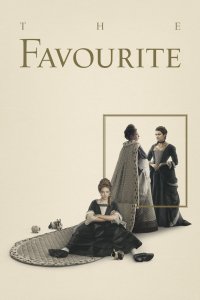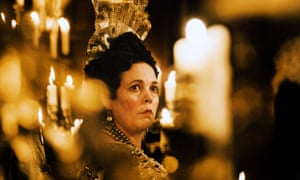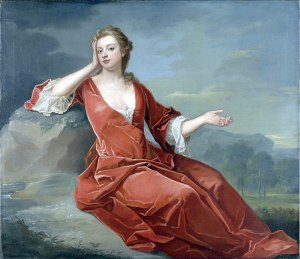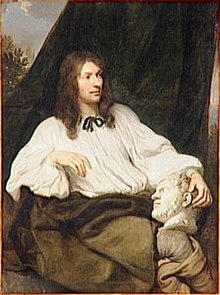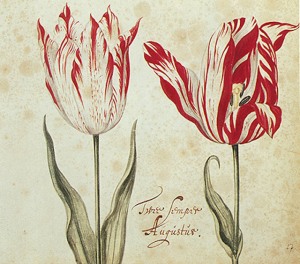A key plot point of The Favourite (2018, dir. Yorgos Lanthimos) is that Queen Anne (Olivia Colman) is in a secret lesbian relationship with Sarah Churchill (Rachel Weisz). When Abigail (Emma Stone) discovers this, she sets out to replace Sarah in Anne’s bed as well as her confidences. When Sarah discovers that she’s been replaced, she blackmails Anne by threating to publish Anne’s letters which would reveal their intimacies. The film is pretty explicit, presenting sex scenes and showing Abigail naked in Anne’s bed. So how true is this? Was Anne a lesbian?

“Spoiler” Alert: Since the film is still in the theaters, you may wish to see the film before you read this review, since I do discuss key details of the film. However, if you know anything about Anne and Sarah Churchill, there’s not really anything to spoil. There are no unexpected plot twists, so you can probably just keep reading.
First, as I’ve mentioned before, analyzing the sexuality of historical figures can be difficult. The modern language of homosexual/bisexual/heterosexual didn’t exist until the later 19thcentury, and the concept of ‘sexual orientation’ didn’t exist either. The word ‘lesbian’ wouldn’t acquire its modern usage until that time. (Prior to then, it just meant someone from the island of Lesbos.) However, for the purpose of this post, I’m going to refer to female same-sex desires and sexuality activity as “lesbianism”, simply because it’s the term we tend to use nowadays. Note that the term as I am using it here doesn’t refer purely to women who felt desire exclusively for other women. All the women we’re going to discuss here were married and had multiple children, and so may have been bisexual as much as lesbian in modern terms.
In the 17thand 18thcenturies it was understood that some people did have sex with members of their own sex, but this was seen more as an immoral activity than an innate difference in their sexuality. In this period, male homosexuality was generally scorned. Female homosexuality was less acknowledged, in part because in the absence of a penis, it was less clear that what two women did in bed together was actually sex. (Indeed, there is evidence that some 19thcentury lesbians may not have recognized their own intimate relationships as sexual even when they seem to us to be having sex. If one thinks of sex purely as involving penetration with a penis, a kiss between two women is not sex, regardless of where that kiss might be planted.)
That said, the 17th century had a good deal of room for what we would see as homosexuality and bisexuality among both aristocratic men and women. Anne’s grandfather James I was known to have had many male favorites (although there is no clear evidence he had sex with any of them), and her brother-in-law William III was rumored to have developed a taste for men after his wife’s death (although again, there’s no solid proof he ever did anything). There was a strong culture of female ‘Romantic Friendship’ in the Stuart period, in which women were encouraged and expected to express their feelings for female friends in terms comparable to those expected between a heterosexual couple. The culture of Romantic Friendship particularly flourished in the period after the Restoration of the Monarchy in 1660.
Some scholars, especially LGBT scholars, have explored the extent to which Romantic Friendship may have expressed or served as cover for actual lesbian relationships. There was court gossip about ladies-in-waiting having affairs with each other. While this was immoral by the standards of the day, it wasn’t illegal (whereas male homosexuality was), and because it posed no threat to a man’s control of his wife’s reproduction, it was mostly permitted.
If this interests you, you might check out Heather Rose Jones’s Lesbian Historic Motif podcast. Jones is a historical fiction author who has done a good deal of writing exploring the lesbian text and subtext of late Stuart literature and devotes a whole episode of her podcast to the question of Anne’s sexuality, where she digs into the context more deeply than I do here. (She takes a much more favorable view of Sarah Churchill than I do, tending to accept Sarah’s characterization of Abigail Hill as a schemer and viewing Anne as vulnerable to the manipulations of others.)
Anne’s Marriage
The starting point for any discussion of Anne’s sexuality has to be her marriage, because it provides our only solid evidence for Anne’s sexual activity. Anne married her cousin Prince George of Denmark in 1683, when she was 18 years old. The marriage was arranged a few years earlier for diplomatic reasons, so Anne had no real choice as to her husband.

Queen Anne
The marriage lasted down until George’s death from respiratory problems in 1708. By most measures, it was a happy marriage. Anne and George got along quite well, and spent the majority of their marriage living together, which was definitely not a requirement of marriages at the time. George was not a particularly ambitious man and seems to have been quite clear that he was the junior partner in the marriage, especially after Anne became queen. During her reign, he only ever attempted to strongly influence her once, when he sought to persuade her that she had to accept the removal of one of her trusted ministers. To judge by the frequency with which Anne got pregnant (three times in one year at one point), they appear to have had a very healthy sex life, and Anne was deeply distressed when George died. Soon after his death, Sarah ordered his portrait removed from Anne’s bedroom, on the theory that seeing the portrait would increase Anne’s distress, but Anne was very upset by the action and found Sarah to be cruel.
The one way in which the couple were not happy was in the area of child-bearing. In this arena, the couple suffered profound tragedy. For a woman in her position, having a child was a vital consideration, and on top of that Anne seems to have had very intense maternal instincts. But her health was poor most of her life (indeed, she was essentially an invalid her entire reign), and bringing a healthy child to term was extremely difficult for her.
She got pregnant very soon after her marriage and between then and 1700, she had at least 17 pregnancies. (I say “at least” because she also had either two or three false pregnancies. There is some uncertainty about the outcome of the first of those potential false pregnancies.) Of those 17 definite pregnancies, 7 ended in miscarriages, 5 ended in stillbirths, and 5 ended in live births. Of the five live births, two lived for less than two hours. Her daughter Mary was born in June of 1685 and her daughter Anna Sophia was born in May of 1686. Both died in February of 1687 from smallpox.
Only William, born in 1689, made it out of infancy. But he was always a sickly child. He suffered from convulsions and hydrocephalus (“water on the brain”) and experienced developmental problems; he didn’t walk until he was three and wasn’t really speaking until he was five. But in 1700 he fell ill on his eleventh birthday with what was variously diagnosed as smallpox or scarlet fever and died six days later. Anne had suffered a stillbirth earlier the same year, and so she and George hoped that she might still produce a child, but that stillbirth was her last known pregnancy.

Prince George of Denmark
Anne’s tragedy, then, was that despite being able to get pregnant quite easily and being desirous to have children, her own medical conditions apparently made it very difficult for her bring a healthy child to term. The loss of so many children was unusual, even by the standards of her day in which high rates of child mortality were common. Her mother Anne Hyde had 8 children, three of whom lived less than a year and three more of whom died before the age of five. Her older sister Mary suffered between one and four miscarriages and never had a sustained pregnancy. So the Stuarts were familiar with this sort of domestic tragedy, but not on the same scale.
If all we had to go on was the available facts of her marriage, no one would suspect that Anne was anything other than a heterosexual woman with a healthy libido and a close relationship with her husband for 25 years. So where do these suspicions of lesbianism come from?
Sarah Churchill
Anne seems to have had a strong need for a female presence in her life. Between age 4 and age 6 ½, she lost her grandmother, her aunt, and her mother, and this may have contributed to a desire for an intimate relationship with a woman. She seems to have been close to her older sister Mary, but when Anne was 12, Mary left to get married to William of Orange and the two did not see each other much until Mary returned as queen in 1685, eight years later. Anne loathed her Catholic step-mother Mary of Modena and in 1688 actively spread rumors that her step-mother was faking a pregnancy. So Anne’s need for a female relationship could not be met within her family circle.
It’s also clear that there was some concern that Anne felt deep attachment to the women around her. When she was a girl, Anne’s father James became worried that Mary Cornwallis, one of Anne’s ladies-in-waiting, exercised too much influence over her and dismissed her. Her uncle Charles II is once reported to have said that “no man ever loved his mistress as [my] niece Anne did Mrs Cornwallis.”
Anne’s relationship with Sarah Churchill provided her with a female authority figure she could be close to. They met in 1671, when Anne was six and Sarah was eleven. Anne was a shy, quiet girl who grew into a shy, quiet woman, while Sarah was a witty, vivacious, confident girl who grew into an increasingly over-confident and arrogant woman. Anne may have been attracted to Sarah’s outgoing nature as the opposite of her own.

Sarah Churchill. Note the key on her hip–that’s the symbol for her office as Mistress of the Privy Purse
For most of the remainder of Anne’s life, the two regularly exchanged letters that reflect an intense degree of feeling. One of Anne’s letters, from 1683, says “lett me beg you not to call me your highness but be as free with me as one friend ought to be with another & you can never give me any greater proofe of your frieindship then in telling me your mind freely in all things.” (quoted in Gregg, Queen Anne, p. 81; all spelling is original) Sometime in the next 6-7 years, the two of them agreed to pet names for each other: Anne was Mrs Morley and Sarah was Mrs Freeman. This is not as strange as it sounds. Anne did something similar with another young female friend, and it was not uncommon in this era for people to use ‘cant’ names in correspondence as a way to be discreet. In Abigail’s surviving correspondence, Anne is her “aunte Pye”.
Anne’s surviving letters are full of expressions of how deeply she loves Sarah. Phrases like “dear Mrs Freeman” and “your poor unfortunate faithful Morly” recur over and over in Anne’s writing. When Sarah and her husband talked of returning to their estates not long after Anne’s coronation, Anne wrote, ‘The thoughts that both my dear Mrs Freeman & Mr Freeman seems to have of retyering [retyring] gives me no small uneasiness…if ever you should forsake me, I would have nother more to do with the world, but make another abdication…I never will forsake your dear self, Mr. Freeman…but allways be your constant faithfull servant…” (quoted in Gregg, Queen Anne, p. 171).
Although contemporaries commented on how close they were and how much they loved each other, they weren’t so close that Sarah didn’t spent a great deal of time away from court. In her letters, Anne frequently complains of Sarah’s absence and asks her to come back to court. The Favouritedepicts Sarah as almost entirely living at Anne’s (unspecified) palace, but this is definitely untrue.
But there are two things missing from the picture provided by the correspondence. One is Sarah’s half of the correspondence. Anne, following Sarah’s request, burned most of Sarah’s letters after reading them. So we can’t easily gauge whether Sarah’s letters included such fervent statements of devotion or whether the relationship was more about Anne adoring Sarah because Anne needed someone to devote herself to. It seems clear that Sarah must have returned Anne’s devotion to some extent; Anne was neither blind nor stupid. But whether Sarah reciprocated Anne’s emotional outpourings the way a romantic partner might is just not clear.

George and Anne
The other thing that’s missing is anything overtly sexual in these letters. Anne clearly loved Sarah deeply, but there’s no indication in the letters that she loved Sarah carnally. She desired Sarah’s presence and attention, but there’s no evidence that she desired Sarah’s body.
Starting in the 1980s, LGBT scholars and amateur historians became interested in “queering the past”. Queering, simply stated, involves looking at an historical person and asking if there is any evidence that person was homosexual. Queering attempts to reclaim a lost LGBT past by reading historical evidence the way LGBT people have often learned to read each other’s small clues of body language, clothing, grooming, and speech. It’s sort of an exercise in ‘historical gaydar’. Because LGBT people generally have to learn to read each other’s subtext to find each other, the idea is that LGBT scholars can spot evidence of same-sex desires in the writings and activities of historical figures.
So while at first glance Anne’s letters seem completely non-sexual, some people have detected veiled sexual desire in words like “passion” and “inclination”. Personally, while I’m very sympathetic to the project of reclaiming the LGBT past, in Anne’s case, I don’t see it, and most other scholars don’t see it either. Anne doesn’t make much reference to Sarah’s appearance or body, she doesn’t mention any desire to touch or hold Sarah, she doesn’t resort to sexually-suggestive metaphors. She just says she loves Sarah, misses her, is devoted to her. This seems to be the language of friendship, not sexual desire.
If all we had to go on was Anne’s letters, there is no reason to think that this relationship was anything other than the sort of typical emotionally intimate relationship 17thand 18thcentury women were encouraged to have with each other. So where do these suspicions of lesbianism come from?
Enter Abigail
Abigail Hill entered Anne’s service probably in 1697 or so, when Anne determined that one of her “women of the bedchamber” was becoming too old to perform her duties. The women of the bedchamber performed tasks such as helping the queen bathe and dress (but not menial tasks such as scrubbing floors or doing laundry). By 1705, Abigail had some degree of influence with the queen, who agreed to grant her brother a military commission.
In 1706, George’s groom Samuel Masham came back to court after an absence and evidently began romancing Abigail. A year later, the queen arranged to assign Masham command of a regiment that was normally stationed in Ireland while allowing him to remain at court. This was probably done because Samuel and Abigail were courting, since sometime between April and June of that year, the two of them married at Kensington Palace at a moment when Anne was residing there. Anne seems to have given Abigail a rather handsome dowry of £2,000.

This portrait may or may not represent Abigail Masham
All of this was kept secret from Sarah, who only found out later that year when she noticed the queen’s withdrawal of the money from the account books (which Sarah, as Mistress of the Privy Purse, was responsible for). The queen realized that Sarah would take this poorly, and indeed she did, leaping immediately to the unwarranted conclusion that Abigail was now Anne’s favorite. Sarah retained that conviction for the rest of her life, even though it appears to have been untrue. Anne appears to always regarded Abigail as a servant, albeit one she was fond of. For example, Abigail seems to have had very little real influence with Anne in the realm politics; her cousin Edward Harley, who was one of Anne’s most relied- upon ministers, once remarked that while Abigail might be able to pull someone down in Anne’s sight, she did not have enough influence to build someone up. Her main contribution to the politics of her age was to act as a messenger and information conduit between Anne and Harley.
Anne and Sarah’s friendship had already been strained for several years at this point, but Sarah’s paranoia about Abigail caused things to rapidly deteriorate. She stopped residing at Kensington Palace, much to Anne’s dismay. But a year later, when she discovered that Abigail had been permitted to move into some of her rooms in the palace, she furiously paid a visit to court. She brought with her two poems that were currently circulating in London. One was an attack on Abigail’s influence with Harley. The other was about Abigail’s relationship with Anne. Here are four of the 35 verses (set to the tune of “Fair Rosamund,” a ballad about Henry II’s mistress):
When as Queen Anne of great Renown
Great Britain’s scepter sway’d,
Beside the Church, she dearly lov’d
A Dirty Chamber-Maid
O! Abigail that was her name,
She stich’d and starch’d full well,
But how she pierc’d this Royal Heart
No Mortal Man can tell.
However, for sweet Service done
And Causes of great Weight,
Her Royal Mistress made her, Oh!
A Minister of State.
Her Secretary she was not
Because she could not write
But had the Conduct and the Care
Of some dark Deeds at Night.
(quoted in Gregg, Queen Anne, p.275)
As if that weren’t enough of a hint, Sarah sent a letter to the Anne telling her about the existence of the poem and explaining the point of the song.
“…I remember you said att the same time of all things in this world, you valued most your reputation, which I confess surpris’d me very much, that your Majesty should so soon mention that word after having discover’d so great a passion for such a woman, for sure there can bee noe great reputation in a thing so strange & unaccountable, to say noe more of it, nor can I think the having noe inclenation for any but of one’s own sex is enough to maintain such a character as I wish may still be yours.” (quoted in Gregg,Queen Anne, p.275-6)
While neither the poem nor the letter explicitly says it, the implication is obvious–there are rumors that Anne is having sex with Abigail. This is the first solid evidence that anyone thought Anne was sexually interested in women.
Another anonymous pamphlet of the period depicts Abigail Masham having a fictional conversation with Madame de Maintenon, Louis XIV’s one-time mistress and now wife. In it, Abigail admits that she was suspected of having too-great an attachment to women, which caused her to find a husband to cover her sexual activities. The pamphlet doesn’t say she was having sex with the queen however. It leaves the identity of her lovers up to the reader’s imagination.
The fact that there was a poem and a pamphlet circulating in London gossiping about Anne’s and Abigail’s sexuality suggests at first glance that there must have been serious talk about that relationship. But there is more going on than it looks on the surface. Although it’s not proven, it’s usually thought that these poems and the pamphlet were written by Arthur Maynwaring, a hardcore Whig member of Parliament. He was also an author who specialized in scurrilous political writings that attacked the Crown and defended Whigs like Sarah’s husband. He was very close to Sarah and considered himself her secretary.

Arthur Maynwaring
This raises the very real possibility that Maynwaring wrote this material at Sarah’s behest. Attacking one’s political opponents in anonymous writing was a common tactic in the late 17thcentury. Sarah was at one point the target of a thinly-veiled roman a clef that depicts her as the center of a circle of lesbians at court. It’s also noteworthy that these works are not attacks on Anne; they’re directed at Abigail, which increases the likelihood that they are Sarah’s effort to undermine Abigail, not efforts to ruin Anne’s reputation.
This poem and this pamphlet are the entirety of the documentary evidence that Anne had sex with women, and they seem to originate from a woman who was bitterly angry at Anne for what she perceived as Anne’s mistreatment of her. If she herself did not ask Maynwaring to write these works, he certainly was drawing on what she had to say about Anne and Abigail. So these sources are not independent evidence that people in early 18thcentury London thought the queen was a lesbian. They’re really just evidence that someone, probably Sarah, was accusing Abigail of being a lesbian as a way to get Anne to dismiss her from the royal household.
Sarah continued making these claims to Anne until the final collapse of their friendship. But she went a step further. She pointed out to Anne that she could publish the queen’s letters to her if she wished, essentially resorting to blackmail, although she never actually did publish them. Anne clearly took these threats seriously. In the long run, Anne chose to pay her off. Unfortunately we don’t have the last of Sarah’s account books from her time as Mistress of the Privy Purse, but Edward Gregg speculates that Anne permitted Sarah to write off £20,000 that Sarah had borrowed from the Privy Purse to help fund the construction of Blenheim Palace, on top of giving her a £12,000 grant in 1708. That’s an enormous sum of money for the period. Basically, Sarah made out like a bandit from the end of her relationship with the queen.
To my mind, this fact—that the queen paid Sarah so much money to not publish her letters—is the only serious evidence that Anne may have been a lesbian. Why would Anne have paid Sarah off to such a degree if there wasn’t anything inappropriate in those letters?
There seem to be only three possibilities here. First, and least likely, perhaps those letters contained something inappropriate but non-sexual. It’s hard to imagine what that might be, and the fact that Sarah chose to make lesbianism the center of her threat also works against that, so we can probably discard that possibility.

A coin of Anne’s reign
Second, Anne may have made more open references to sexual activity with women in those letters. If that’s the case, it would have had to have been sex with Sarah, not Abigail, because the letters in question mostly pre-date Sarah’s suspicion that Abigail was displacing her. So Sarah was threatening to reveal that she and Anne had been lovers by publishing letters that offered explicit or nearly-explicit references to them having sex. But if that’s true, it was a very risky gambit for Sarah, because actually following through on that threat would have revealed her as a lesbian, and it would have ruined her reputation as well as Anne’s. She was essentially holding a hand grenade and daring Anne to pull the pin, knowing it would blow both of them up. Given Sarah’s later obsession with controlling her reputation through her memoirs, it’s hard to imagine that she would ever have actually taken that step. If this is the right scenario, the incriminating letters must have been destroyed, because they’ve never come to light among the letters Sarah possessed.
Third, there was nothing more incriminating in those letters than Anne’s intense statements of devotion, but Sarah was playing on Anne’s shyness and need for privacy to make Anne feel threatened. Anne was an intensely private woman who only opened up to a few trusted friends. She was deeply loyal to the members of her household; Beata Danvers literally served Anne all the way through her life and reign and Anne only replaced Ellen Bust when it became clear that Ellen was close to death. Sarah’s break with Anne wasn’t just the end of a friendship; it must have felt like a profound betrayal of Anne’s trust, especially as it culminated in blackmail. Perhaps Sarah was able to make Anne think that those letters said something worse than they really did, that Anne had crossed some line into lesbian sentiment.
To me, the third scenario seems most likely. I’m simply not convinced that we have enough evidence to conclude that Anne ever had sex with another woman. It seems more plausible to me that these claims stemmed entirely from Sarah Churchill’s anger over the breakdown of her friendship and her sense, at least partly untrue, that her cousin Abigail had displaced her. There’s just no independent evidence that Anne engaged in sex with women and it’s too easy to see how Sarah might have fabricated the rumors for her own purposes. Even Jones seems to feel the evidence is inconclusive.
It’s also hard to write off Anne’s 17 pregnancies as merely pursuing her duty to produce an heir, especially given that those pregnancies were clearly damaging her health. If she had found sex with George unpleasant, she could easily have put off sex with the excuse that she was not recovered enough from her previous prenancies or that she was too frail. If Anne was involved in women, I think we have to say that she was bisexual rather than homosexual.
However, none of this goes to prove that Anne did not have lesbian desires. It’s clear that her relationships with her female friends were intense (although her love for Prince George seems to have been pretty intense as well and no one ever considers that as evidence that she was heterosexual). Those relationships were intense enough that people around her were aware of her strong affections for women, and this was a trait she demonstrated throughout her life. I don’t think her letters reveal definite evidence of same-sex attraction, but I don’t think we can say they don’t support at least the possibility of it. And the second possibility, that Anne’s letters contained something explicit, cannot be entirely discounted.
I’ll give Jones the last word on the issue:
“…When one digs through the coded language, even if one takes an extremely conservative position that the sexual allegations were all politically motivated, it’s undeniable that Anne’s deepest and most lasting relationships were all with women like Sarah Churchill and Abigail Masham, and that those relationships existed in a cultural context where other women with such bonds definitely were engaging in sexual relationships. So, lesbian or not? The distinction seems scarcely worth making.”
Want to Know More?
The Favourite is still playing in theaters and so isn’t available on Amazon yet.
Although it’s close to 40 years old now, Edward Gregg’s Queen Anne is still probably the essential historical take on her.
If you’re interested in the issue of homoesexuality in late 17th century England, take a look at Valerie Traub, The Renaissance of Lesbians in Early Modern England and Alan Bray, Homosexuality in Renaissance England as well as Jones’ Lesbian Historical Motif podcast.




















